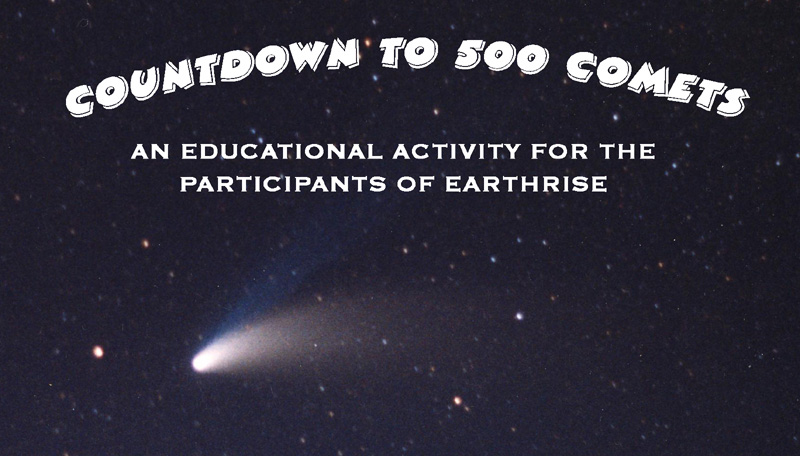
Comet Tally Pages (comets 401-500)
Photo and image gallery (comets 1-400)
Photo and image gallery (comets 401-500)
List of mentors and other assistants
Comet Observing Award recipients
Latest update: January 28, 2012
As I add comets number 401 through 500 I will update this page with information about each comet, and give information as to where to look for it, how bright it is at that point, and so on. I will also try to feature at least one CCD image or photograph of each comet; initially, these will most likely be taken with one of the portable telescopes owned by the Earthrise Institute, but once our dark-sky site becomes operational and then other Earthrise sites come on-line, we will feature images taken with telescopes at these sites. (In fact, we hope to be set up so that Earthrise participants will be able to take images of the comets with these telescopes.) We will also provide links to, and/or post on this site, images taken by our astronomical colleagues around the world. If you have the capability of taking images of these comets with your own equipment, please send them to us for posting, or provide us a link to where you have them posted.
I cordially invite all the astronomy students of the world, of all ages and nationalities, to join with me as I seek to observe these next 100 comets, and I encourage all of you to observe as many of these as you can. Some of these will be short-period comets making expected returns, and others will be newly-discovered long-period comets. About one or two per year, on the average, will become bright enough to view with the unaided eye. It is possible that one or more of these will be "Great" comets, although there is no way to tell right now -- but that's part of the fascination with these objects.
Based upon the rate I have been adding comets over the past several years, I estimate it will take me between five and seven years to accomplish this. On the average this works out to slightly more than one comet per month, although this will vary widely. I'll update the tally pages whenever I add a comet to my list, and I'll also write updates to the update page about once a week to give information about comets that I'm presently observing and describe where they are and how they're doing. I'll also probably add a few happenings from my personal life as well from time to time, since all of this takes place against the backdrop of our lives in the non-astronomical world.
If you observe these comets, I would like to hear from you. I will maintain a list, on this site, of all astronomers and astronomy students who successfully observe at least one of these comets and who writes to tell me about it. The Earthrise Institute will also present a special award to any student who successfully observes ten or more of these comets. (We are looking for a donor to help name this award.) In keeping with the spirit of Earthrise, let's make this a project with comet observers from all over the world!
So, journey with me as I continue this quest, and look to the skies as we examine these wanderers into the inner solar system. Be sure to check out the basic information on comet observing, and the photo and image galleries of comets 1-400 and comets 401-500.
Clear skies to all,
Alan Hale
President and founder, the Earthrise Institute
March 1, 2007